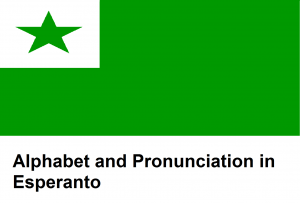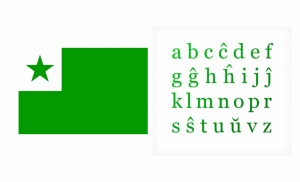Language/Esperanto/Pronunciation/Alphabet-and-Pronunciation
Hello everybody,
In today's lesson, you will learn everything about the ¨ALPHABET AND PRONUNCIATION¨ in Esperanto. As an Esperanto language teacher with 20 years of experience, I am excited to guide you through this essential aspect of the language. Remember, in Esperanto: one letter - one sound. No exceptions.
The Esperanto alphabet consists of 28 letters, including six unique letters not found in English: ĉ, ĝ, ĥ, ĵ, ŝ [all circumflexes], and ŭ [a u-breve]. Note that the names of the letters (used when spelling aloud, etc.) are a, bo, co, ĉo, do, e, fo, go, ĝo, ho, ĥo, i, etc. That is, the consonants get an 'o' after them, and the name of each vowel is the sound of the vowel itself. Note that "ŭo" is pronounced sort of like English 'wo'.
Once you have mastered the alphabet and pronunciation, you may also be interested in learning how to count to ten in Esperanto, exploring Esperanto weather vocabulary, and understanding how to use "be" in Esperanto grammar.
Feel free to edit this page if you think it can be improved! Enjoy your journey into the world of Esperanto pronunciation. 😊
- The Esperanto alphabet: a b c ĉ d e f g ĝ h ĥ i j ĵ k l m n o p r s ŝ t u ŭ v z
Vowels[edit | edit source]
Vowel Sounds (accented/emphasized vowels are capitalized)
- a as in Ma, father: blANka sAna grAnda vArma
- e as in send, met: bEla plEna vErda pEti
- i as in me, three: vIvi Ami trInki fIlo
- o as in more, or: Ovo dOmo kIo nOva
- u as in two, soon: Unu plUmo sUno butIko
Consonants[edit | edit source]
Consonant Sounds (mainly as in English, except:)
- c pronounced ’ts’ in nests: dAnco leciOno bicIklo
- ĉ pronounced ’ch’in church: ĉAmbro sandvIĉo ĉokolAdo
- g pronounced ’g’ in great: sagEto gustUmi geografIo
- ĝ pronounced ’g’ in George: mAnĝi lOĝi sEĝo
- ĥ pronounced ’ch’in Bach: jAĥto ĥOro Eĥo
- j pronounced ’y’ in yet: jEs jAro jUna
- ĵ pronounced ’s’ in leisure: ĵurnAlo teatrAĵo ĵalUzo
- ŝ pronounced ’sh’in shoe: ŝAti pOŝo ŝUo
- ŭ is used most often in the combination ’aŭ’ or ’eŭ’ (otherwise it has a ’w’ sound, as in weather).
Remember: All sounds presented in this Pronunciation Guide are approximations. They are the closest approximations for North American English-speakers.
Diphthongs[edit | edit source]
Vowel Glides (diphthongs). The following combinations between a vowel (a, e, o, u) and ’j’ or ’ŭ’ make one sound:
- aj pronounced as ’eye’: mAjo kAj semAjno
- oj pronounced as in ’boy’: knAboj vojAĝi ĝOjo
- ej pronounced as in ’they’: plEj mEjlo lernEjo
- uj pronounced ’oo-ee’ (quickly) tUj AnglUjo monUjo
- aŭ pronounced as in ’cow’: nAUX Antaŭ ĵAUXdo
- eŭ pronounced as in ’wayward’: EŭrOpo neŭtrAla EŭklIdo
In all the examples above, the vowel of the stressed (or accented) syllable has been capitalized. This follows the rule without exception that every word in Esperanto is stressed on the next-to-last syllable.
Practice[edit | edit source]
Here is a list of words (and translations) that represent sounds in Esperanto [not just those covered above]. Practice them carefully and your pronunciation will get better and better.
| Esperanto | Translation |
|---|---|
| Anglujo | England |
| lernejo | school |
| antaŭ | before |
| majo | May |
| aĉeti | to buy |
| manĝi | to eat |
| biciklo | bicycle |
| mejlo | mile |
| ĉambro | room |
| monujo | purse |
| ĉokolado | chocolate |
| neŭtrala | neutral |
| danco | dance |
| ovo | egg |
| domo | house |
| plej | most |
| eĥo | echo |
| plena | full |
| Eŭropo | Europe |
| poŝo | |
| Eŭklido | Euclid |
| sageto | dart |
| sandviĉo | sandwich |
| gustumi | to taste |
| seĝo | seat, chair |
| ĝojo | joy |
| suno | sun |
| ĥoro | choir |
| ŝati | to like |
| jaĥto | yacht |
| ŝuo | shoe |
| juna | young |
| teatraĵo | (theatrical) play |
| ĵaluzo | jealousy |
| tuj | immediately |
| ĵaŭdo | Thursday |
| vojaĝi | to travel |
| ĵurnalo | newspaper |
Pronunciation in different languages[edit | edit source]
| ESPERANTO | PRONUNCIATION ENGLISH | PRONUNCIATION
BRAZILIAN PORTUGUESE |
|---|---|---|
| A | ah | a |
| B | b | b |
| C | ts | ts |
| Ĉ | ch | tch |
| D | d | d |
| E | eh | e |
| F | f | f |
| G | g | Sempre a letra (g) como em ga / gue / gui / go / gu
Obs.: nunca como em girafa / gelo (som de j) |
| Ĝ | j | dj |
| H | h | H |
| Ĥ | kh | H |
| I | ih | i |
| J | ih | i |
| Ĵ | zh | Letra (j) como em janela / jeito / jipe / jóia / jumento |
| K | k | k |
| L | l | l |
| M | m | m |
| N | n | n |
| O | oh | o |
| P | p | p |
| R | r | r |
| S | s | s |
| Ŝ | sh | ch |
| T | t | t |
| U | ou | u |
| Ŭ | ou | u |
| V | v | v |
| Z | z | z |
Letter Pronunciation and IPA[edit | edit source]
Letters[edit | edit source]
Esperanto pronunciations are designed to be simple, though there is still an alveolar trill.
| Letter | A a | B b | C c | Ĉ ĉ | D d | E e | F f | G g | Ĝ ĝ | H h | Ĥ ĥ | I i | J j | Ĵ ĵ | K k | L l | M m | N n | O o | P p | R r | S s | Ŝ ŝ | T t | U u | Ŭ ŭ | V v | Z z |
|---|---|---|---|---|---|---|---|---|---|---|---|---|---|---|---|---|---|---|---|---|---|---|---|---|---|---|---|---|
| IPA | a | b | t͡s | t͡ʃ | d | e | f | g | d͡ʒ | h | x | i | j | ʒ | k | l | m | n | o | p | r | s | ʃ | t | u | u̯ | v | z |
Diphthong[edit | edit source]
If you can't input the accented letters, there are two alternations : 1. add an "x" after the letter; 2. add an "h" after the letter except "u".
| Diphthong | aj | ej | oj | uj | aŭ | eŭ |
|---|
Keyboards[edit | edit source]
Online Keyboards[edit | edit source]
Install on Windows[edit | edit source]
Esperanto keyboard software to install for Windows
Video[edit | edit source]
Esperanto Online Virtual Keyboard[edit | edit source]
Sources[edit | edit source]
https://esperanto-afriko.webs.com/kurso%20angle.pdf



